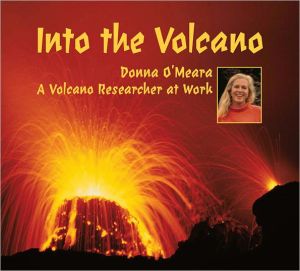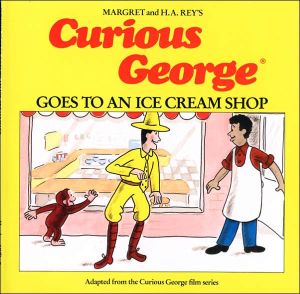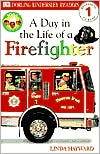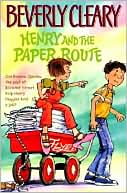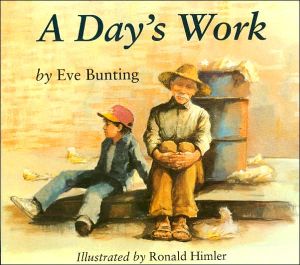Into the Volcano: A Volcano Researcher at Work
In a helicopter with no doors, she hovers over a lava lake the size of two football fields -- then lands! She runs through clouds of scalding steam, dodging lava bombs, to photograph glowing hot lava as it pours into the sea. She sets up camp on the edge of a volcano's cone, only to be hit with hurricane-force winds, poisonous gases and acidic ash. Witness a typical day in the life of Donna O'Meara -- volcano researcher, writer and photographer. Donna's photographs and accounts of treacherous...
Search in google:
Witness the exciting and very dangerous adventures of a volcano researcher at work.Susan Hepler, Ph.D. - Children's LiteratureIn an attractive and varied format, the author tells of how she became interested in the study of volcanoes. She began as a field assistant to her major professor and was soon on the plane to Kilauea to witness its eruption in 1986. Married a year later, the two have made volcano research their lives' work. The dramatic photos show volcanoes erupting, taking over the landscape or covering manmade works, and those scientists who study the phenomenon. Lavishly-captioned photos, green-tinted boxes of other information, and attractively cropped pictures entice readers to browse. Boxed information includes what sort of gear one needs to camp out near a volcano; diagrams of various kinds including strato-, cinder cone, shield, and compound volcanoes; the nature of pyroclastic flows; and a tribute to Katia Krafft, a courageous inspiration to Donna O'Meara, who died in a pyroclastic flow. This informative and personal view of science in action would pair well with Volcanoes: Journey to the Crater's Edge by Philippe Bourseiller (Abrams, 2003), another book that presents for slightly older readers this geologic marvel in a way that inspires young would-be scientists while fascinating the rest of us. Middle school and upper-elementary age readers who are interested in careers in science will also find this book of use. 2005, Kids Can Press, Ages 9 to 14.
\ BooklistIllustrating the text are exceptionally fine photos of volcanic landscapes and members of the expeditions. Sidebars carry clear descriptions and pictures (often diagrams) related to such topics as the formation of volcanoes, the types of lava, and the Volcanic Explosivity Index ? A natural for nonfiction booktalking.\ \ \ \ \ Washington PostRiveting ? filled with stunning color photographs and an abundance of basic volcano information, placed in easy-to-digest sidebars.\ \ \ From the PublisherThe O’Mearas’ cameras catch somnolent giants and vivid eruptors alike, and fill the pages with pyrotechnic displays and incandescent lava streams.\ Illustrating the text are exceptionally fine photos of volcanic landscapes and members of the expeditions. Sidebars carry clear descriptions and pictures (often diagrams) related to such topics as the formation of volcanoes, the types of lava, and the Volcanic Explosivity Index ? A natural for nonfiction booktalking.\ Riveting ? filled with stunning color photographs and an abundance of basic volcano information, placed in easy-to-digest sidebars.\ \ \ \ \ \ Children's LiteratureIn an attractive and varied format, the author tells of how she became interested in the study of volcanoes. She began as a field assistant to her major professor and was soon on the plane to Kilauea to witness its eruption in 1986. Married a year later, the two have made volcano research their lives' work. The dramatic photos show volcanoes erupting, taking over the landscape or covering manmade works, and those scientists who study the phenomenon. Lavishly-captioned photos, green-tinted boxes of other information, and attractively cropped pictures entice readers to browse. Boxed information includes what sort of gear one needs to camp out near a volcano; diagrams of various kinds including strato-, cinder cone, shield, and compound volcanoes; the nature of pyroclastic flows; and a tribute to Katia Krafft, a courageous inspiration to Donna O'Meara, who died in a pyroclastic flow. This informative and personal view of science in action would pair well with Volcanoes: Journey to the Crater's Edge by Philippe Bourseiller (Abrams, 2003), another book that presents for slightly older readers this geologic marvel in a way that inspires young would-be scientists while fascinating the rest of us. Middle school and upper-elementary age readers who are interested in careers in science will also find this book of use. 2005, Kids Can Press, Ages 9 to 14. \ —Susan Hepler, Ph.D.\ \ \ \ \ School Library JournalGr 5-8-Dodging "lava bombs" and skittering across barely hardened crusts of pahoehoe may not be everybody's cup of tea, but for these volcano researchers, it's simply a way of life. In conversational prose, O'Meara records some of the truly dramatic adventures she and her husband have had around the world, scaling active volcanoes and recording data that may one day save human lives. The O'Mearas' cameras catch somnolent giants and vivid eruptors alike, and fill the pages with pyrotechnic displays and incandescent lava streams. For avid report writers, the author includes some nifty volcano data, details on their structure, and on the varieties of lava. Volcanologists are few and far between, and this first-person narrative will be an eye-opener to kids who equate eruptions with papier-m ch mounds, baking soda, vinegar, and some red coloring at the school science fair.-Patricia Manning, formerly at Eastchester Public Library, NY Copyright 2005 Reed Business Information.\ \ \ \ \ Kirkus ReviewsAt 32, O'Meara went back to college and fell in love with volcanoes and the instructor who introduced her to volcano watching; they have been researching volcanism ever since. This personal account combines their experiences with a fast-paced introduction to the science of volcanoes. O'Meara describes harrowing visits to volcanoes of different types: Kilauea in Hawaii, Arenal in Costa Rica, Pacaya in Guatemala, and Stromboli off the coast of Italy. Sidebars add scientific fact (the formation of volcanoes, the nature of pyroclastic flows) or interesting additional details (life in the rainforest on Kilauea, necessary gear for volcano watching). Readers accustomed to sharp reproduction may be disappointed by the quality of the illustrations: Photographs taken by the author and her husband, ranging from dramatic full-page scenes of sparkling molten hot lava to snapshots of the two on various occasions including their wedding. Like titles in Houghton Mifflin's Science in the Field series, this volume will introduce young readers to a passionate scientist at work. (glossary, index) (Nonfiction. 10-14)\ \
